fDOM Sensor Research
Undergraduate student Alexandra Norelli, at the University of South Carolina Marine Science Program, has conducted a truly objective review of EXO’s fDOM sensor technology. Under the guidance of Research Coordinator Erik Smith, Ph.D., of the North Inlet-Winyah Bay National Estuarine Research Reserve (NERR) – the team applied the principles and scrutiny of the scientific method to evaluate the efficacy of EXO’s measurement of in-situ fDOM (fluorescent dissolved organic matter) to serve as a reliable and robust proxy for dissolved organic carbon (DOC) measurements. 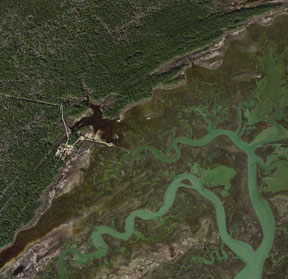
They concluded in their poster presentation to the Southeastern Estuarine Research Society that “the use of continuously deployed fDOM sensors…provides the opportunity to greatly improve the understanding of estuarine DOC dynamics”.
The presentation ultimately awarded Alexandra “best undergraduate presentation” and according to Erik Smith, “there was quite a bit of interest in the fDOM probe and her results.”
Background
To fully understand their conclusions and process – let’s start with the basics. For those that may not know, estuaries are zones where freshwater streams come into contact with the open sea. The resulting mix of fresh and saltwater creates what’s known as brackish water, and these zones tend to have high levels of nutrients making estuaries among the most productive aquatic environments known.
Due to the abundance of organic material in productive waters dissolved organic carbon (DOC) becomes a key indicator in predicting the health and future of an estuary ecosystem. DOC acts as a food supplement that supports the growth of microorganisms and also plays an important role in the global carbon cycle.
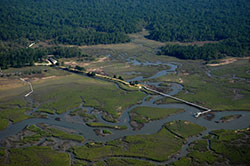
Aerial view of Oyster Landing, the NERR site where brackish water samples are regularly taken for research into dissolved organic carbon. Image credit: Erik Smith, Ph.D.
Traditionally, DOC samples are collected manually at remote sites and returned to the lab for direct analysis of carbon concentration. Unfortunately, this analysis is costly and labor-intensive, meaning that collecting continuous high-frequency measures of DOC is not routinely feasible.
YSI’s EXO platform provides the potential to quantify DOC dynamics over time scales and frequencies not previously possible. With the ability to log multiple parameters at much higher frequencies of measurement (in this case 15-minute intervals) it is now within the realm of possibility to determine the effects of short-lived events on the local DOC content. What still wasn’t known, however, was whether or not the advantages of an in-situ probe were as reliable as the traditional grab sample method and could it be used as a suitable proxy.
The primary objective of Alexandra and Erik’s study was to determine the effects of temperature, turbidity, salinity, chlorophyll fluorescence, and DOC sources on the performance of the EXO fDOM sensor. They knew that similar studies had been conducted already on fDOM probe performance in freshwater systems – however, no such study had been conducted in brackish or estuary environments. Their study, therefore, is critically important not just for the long-term viability of the EXO fDOM sensor, but for the future of estuary dynamics as a discipline.
“The [fDOM] probe allows us to supplement the (infrequent and expensive) grab samples to observe temporal detail in DOC dynamics that was simply not routinely feasible with traditional methods.”
Assessment Methodology
To determine if the EXO fDOM sensor was truly fit for the job the team at USC applied the objective methods of a true scientific study. All laboratory trials were conducted in a darkened 20L tank containing a YSI EXO sonde equipped with fDOM, temperature, salinity, and turbidity probes. A sampling port allowed sub-samples to be simultaneously withdrawn for discrete analysis. Prior to each sampling event, all EXO probes were calibrated according to YSI’s specifications. The fDOM probe specifically was calibrated using Quinine Sulfate as a standard.
All of the samples were collected from Crab Haul Creek in the North Inlet estuary in Georgetown, South Carolina – the location of the North Inlet – Winyah Bay National Estuarine Research Reserve’s (NERR) long-term monitoring site, known as Oyster Landing. Temperature effects on fDOM measurements were evaluated in filtered water containing variable proportions of DOM-rich water collected from the upper reaches of Crab Haul Creek. In addition, Turbidity effects on fDOM measurements were evaluated by progressively adding a mud-slurry in small increments to the 20L tank, which contained filtered sample water of know fDOM content.
Comparisons of fDOM measurements and in-situ DOC concentrations were made by collecting 20L of water from Oyster Landing at approximate hourly intervals over the course of a day on three separate occasions. Comparing temperature and turbidity corrected fDOM measurements against discreet water samples analyzed for DOC concentration by standard high-temperature combustion methods allowed the team to see if there was a robust correlation between corrected fDOM readings and more thorough, time-consuming lab readings.
Conclusions
In the end, Alexandra and Erik came to a number of interesting conclusions. Chlorophyll and salinity variability had no apparent effect on fDOM sensor readings. Temperature and turbidity on the other hand did affect fDOM readings, but these could be corrected for and compared against traditional grab samples analyzed in the lab. When the corrected fDOM and lab readings were compared a highly significant relationship was observed. Therefore, when properly corrected for temperature sensitivities and potential turbidity interferences it was demonstrated that EXO’s fDOM sensor could be used as a robust measure of DOC concentrations over tidal, seasonal, and rain event time scales.
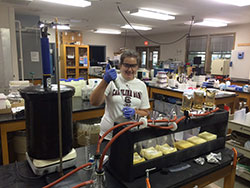
Alexandra Norelli conducting EXO fDOM probe assessment with an EXO1 multiparameter sonde inside of a darkened 20 L tank. Image credit: Erik Smith, Ph.D.
What does this mean in a practical, bread-on-the-table sense? Having demonstrated that the EXO’s fDOM sensor can be applied in both freshwater and estuary environments alike – researchers can now supplement their traditionally expensive grab samples with a relatively low-cost and low-labor alternative. This fundamental difference in how frequently researchers can monitor changes in an estuary system has huge potential in increasing their understanding of DOC dynamics and makes the job significantly easier.
“...the use of continuously deployed fDOM sensors...provides the opportunity to greatly improve the understanding of estuarine DOC dynamics.”
It should come with little surprise then that this research was greeted with praise by the Southeastern Estuary Research Society. As a study, it represents a truly unique investigation into the viability of EXO’s fDOM capabilities and stands as a testament to the scruples of the scientific community. Living the motto “see for yourself”, Alexandra and Erik put YSI’s fDOM sensor to the test to see if it was really up to the task. As it turned out, not only is the sensor ready for longer-term use but it has been shown to have the potential to fundamentally change our understanding of at least one facet of the natural world in which we find ourselves.
Temporal Variability in Estuarine fDOM and DOC Concentrations
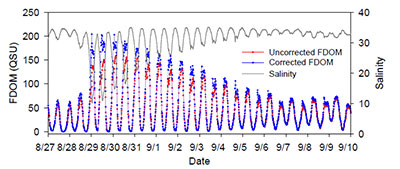
High-frequency time-series fDOM measurements showing tidal variability and effects of a rain-induced input of fDOM to the estuary as well as the importance of correcting fDOM value for turbidity variability.
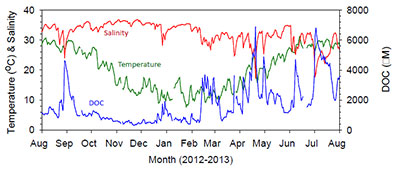
Long-term variability in mean daily DOC concentration derived from fDOM measurements.

Additional Blog Posts of Interest:
Real-Time Water Quality Monitors Gauge Florida Lagoon's Health
Coral Reef Sponge Science - A Cure for What Ails You?
Water Instrumentation Provides Insight for Ecological Research
Water Quality Sonde Detects Tsunami Signal Over 4,000 Miles Away